We, the ones from the Grande Hotel da Beira
photos by Otávio Raposo
We buy ripe mangos at the door of the Grande Hotel da Beira, by the sea, which, even in ruins, has lost neither its majesty nor its magnitude. We ask to talk with the residents’ representative and immediately a boy volunteers to call the “unity’s secretary”, who gets up from his interrupted nap, puts on a blue, buttoned down shirt and Muslim beret and slowly comes, followed by his numerous offspring, to welcome the visitors.
We promptly thank Senhor João for his kindness in showing the hotel at the hottest time of the day. With a stillness and shyness customary to rural Mozambicans, he unfolds the history of a 750 family shelter, comprised of about 3000 people in familial gatherings – in his case 9 elements – who, in one room, do a bit of everything: sleep, bathe, eat, cook. It is the story of a hotel, once a luxury facility, which has turned into one of the biggest “squats” in the world.
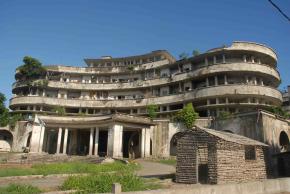
As in any occupied house it has it’s living and organizational rules. There, the following representatives rule: the unity secretary and the secretary of the hallway, block and floor who meet up to solve the residents’ problems, and to conduct the residents’ court in one of the hotel’s former suites. There, discussions concerning who is more entitled to housing (a woman with children has the upper hand), or about who is throwing dirty water onto someone else’s balcony, take place. There are two fundamental rules: “keep the cleanliness and the respect.” The cleaning is maintained by nominating shifts; as for the respect, is has to be kept by everyone. “There have been cases of abuse and rape, and the people who perpetrated these actions were kicked out”, our host tell us with a determined tone.
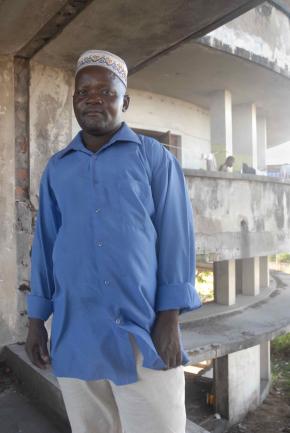 Mr João
Mr João
How did Senhor João end up living in the “apartment building”, a euphemistic nickname to normalize that living experience, and why does he have the highest position of authority? “My brother is in the military, and they were the first to come here in 1980 in order to set up a base during the war. He kept the house and the job and then it passed on to me”. As in bequests, the houses (in this case the rooms) are bequeathed to family members, and some have already been there for three generations, almost thirty years.
Descent to hell
We then begin the visit to the Grande Hotel’s remains. In the staircase women go up with plastic bowls on their heads, boys gather around the sewing machine, and barefooted children play side by side with rats and centipedes. From there you can see the ballroom, where parties and serious meetings take place and where at dusk the loudspeakers flatter the swinging hips of children and teenagers with sounds of “panza” and “tarrachinha”, African songs that call for a lot of synthesizer. It is the exploitation of the space which strikes us immediately: the pool is used to wash clothes, the floorboards were used for fire, and on every patch of land and in every pot a machamba (a small vegetable garden) had been planted. All of the space is valued at this overpopulated house. But precisely because of the original expanse, everything looks paradoxically spacious. In the hallways young people gather in sluggish conversation, women braid hair and breastfeed babies lying down. The rooms are multi-purposed: privacy is divided using thin curtains, a mattress is lifted and a living room or a kitchen becomes visible. There are those who live in the basement, in the former walk-in fridges, in the laundry and in the elevator. Every corner has a function.
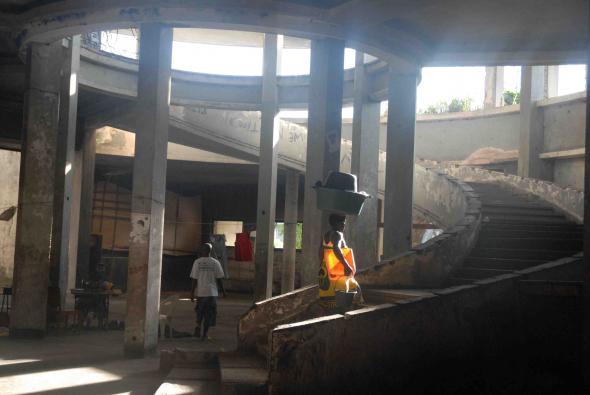
We go up to the rooftop; the Indian Ocean still exists to balance this heavy Beira, which seems to be stuck in time. You go up there to unwind from the excessive human contact and it’s love stories and domestic violence. Inside, you go back to the city of remains, a hotel with an apartment building name. Several activities take place here, ranging from primary classes for the children (promoted by the government), to the sale of shrimp, vegetables (picked right there at the hotel), coal, xima (flour) and fried fish, all of which takes place in the corridors. In the modernist design building, as described by Ana Magalhães in Moderno Tropical (Tinta-da-china 2009), “with a curved façade of monumental composition, lies an alternative city where thousands of people, hundreds of families, live. Inside the gigantic lounges improvised living quarters are established. In the long corridors market stalls are built. In the helical staircase hundreds of children - who the International Red Cross visits at the end of the day - are seen playing.”
In order to live there you have to have good adaptation skills in what concerns diplomacy and sociability. With everyone being so vulnerable, the solidarity networks must work well. Inside the hotel some locks reveal signs of the concern with thieves. Outside the hotel, there is no room for making waves with the police, who pay them security favors and show up to interact with the residents. Being on good terms with the neighbors surrounding the building, on whom you heavily depend, is utterly indispensable. The neighbors sell the much-needed water, which, after being used, is thrown out the window, since there is no trace of a sewage system. The neighbors can give a lift to someone in need of going to the hospital or for any other emergency. There are several comfort schemes which benefit some of the building’s characters with entitlements to pirate the neighbors’ electricity to specific rooms, the selection of said rooms being done using ambiguous and sometimes (let us say) individualistic criteria. The others may resort to more expensive solutions, such as oil lamps and generator batteries, but the large majority submerges into darkness as soon as the sun goes away.
Some outside help from churches, infestation control operations and Red Cross visits assist in minimizing needs. But toughness is the word, and to live there becomes harder every day with problems such as rain, heat, inopportune bugs, electricity, water and privacy shortage, and tensions with the neighbors. ”Just because a human being gets used to a problem, the problem doesn’t cease to exist”, reads a poster on the border between South Africa and Mozambique, and it’s well applied to this life on the edge.
Urbanization utopia, yesterday and today’s
Beira Although desolate and almost abandoned, one can divulge, only by it’s buildings, the glamorous city that Beira had been during the 50’s and 60’s. The railway, the harbor - in a constant flow of passengers and merchandise - embody the “Beira’s passageway”, connecting all the interior of Africa (especially Rhodesia) to the sea. The harsh geographical determinants of the city – low altitude, swampy terrain, humid tropical climate, much heat and rain – did not prevent the urbanization plans.
Declared an urban area in 1892 and given in concession by the State to the Company of Mozambique, Beira was recognized as a city in 1907, with a population growth as explosive as the difficult sanitary conditions of the city. The urbanization plan, by the architect brothers Rebelo de Andrade was conceived in 1932. The architect Jose Porto and the engineer Joaquim Ribeiro Alegre executed some of the construction in consultancy with the Colonial Urbanization Cabinet. The administrative areas were divided into two sectors: the commercial and industrial, and the tourist and residential, according to the European, Asian and African populations.
Beira is home to several projects belonging to the modern model in Africa, embodied by the young architects from the Congress generation who came to experiment building in this language under the influence of the work being developed in Brazil. To better understand this urban dynamic one should read the book “Moderno Tropical”, whose narrative by Ana Magalhães takes as a starting point the photographs by Inês Gonçalves, “connecting the Portuguese architectural patrimony of the twentieth century with the new socio-political contexts” in an attempt to investigate what stays the same in these uneven times. The city prospered, all bets were placed on the colonies without understanding that the imperial and colonialist festivities would soon end for the colonizers and the powers of the metropolis, and the end result would be tragic for a minority and joyful for the majority of the African population. In the period after Mozambique’s independence, with the break of civil war, Beira - being strategically located in the center of the country and home to the Renamo headquarters – would suffer terrible transformations caused by the war including heavy migration and degradation and blockage to it’s infrastructures.
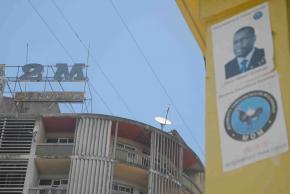
Today, in spite of the peace (forged in 1992), the lack of living conditions persists. Investments are directed more towards Maputo, causing some people to complain of certain blocking and excessive bureaucracy aimed at Beira’s investors. The fact that Daviz Simango, the head of the municipality, doesn’t belong to Frelimo, also contributes. In a country where land is not sold, and where the houses inhabited during the changes of regime did not make it for the generations to come, the fight for a house has been the war of many citizens.
Despite the dynamic trade of the Indians, the city has a desolate and decaying look, with many deteriorated buildings. Among these, the only buildings that had the privilege of being restored are the ones now occupied by banks. They stand in streets where countless people navigate begging for money and aid. Here, much more than in Maputo, the terrible hunger and the detrimental search that persists for external assistance has plagued the Mozambican mentality.
To live and to die in the hotel
They came from the bush, from the deep provinces where you risked your life to steal an atrophied cassava root. They walked from places where in order to attend a ball you had to face the leopards. To everyone, Beira was synonymous with safety; an abstract concept of peace and survival, a name circulating from ear to mouth without anyone truly familiar with it. After running away from the “war of men” they came to face “the war of poverty”, there, in the city.
However “dreams are vast”, Paito’s eyes tell us, in the peak of his 20 years, representing the youth of the building. He lives there out of “necessity and fault” since he was a child. Grown up and attached to the space, conscious that “the situation is extremely bad, but a person gets used to it. Only when someone from the outside comes here, are we reminded of the inhumane conditions we live in”. And Paito has friends outside the building, who frequently spend time there amongst comrades. The friends listen to the conversation and confirm they go there “to visit the guys and attend the parties and the social gatherings” and that the Building has a special feel to it. Being young there is tough - some got into drugs - but it can also be a huge fraternity (this one with older people thrown into the mix). You make music and practice sports, such as soccer, martial arts, and basketball; there is a sort of gym and even a Sports Club of Ponte G that participates in the championship between neighborhoods.
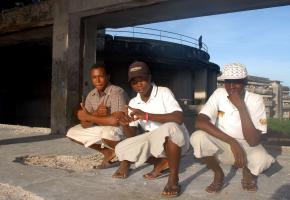
Albino Cardoso, 28, who came from Zambezia 22 years ago, is in charge of the sports activities. Concerning the situation of refugees in the country, he says, “I don’t feel inferior, it was a situation in history. We came after, and the colonizers’ houses had already been given to this person or that. Many of them were colonizer’s former servicemen. We stayed at the hotel, but I already have the conditions to move out”. It is a long struggle to attain those “conditions”, not all of them make it. There are many sinister accident stories that took place inside the Grande Hotel: alcoholics running away from discouragement, who eventually fall from an unprotected staircase or window; a body found floating in the pool; twins who died at the same spot one at a time - a piece of the balcony that fell.
We recognize the shape of Rafate from a distance, the resident madman of the building. He gesticulates and keeps himself busy with strange tasks. He went crazy after an appointment with the healer, who persuaded him to have sex with his mother in order to get rich. He was caught in the act and it disturbed him forever. “Now he even eats dead dogs, cats or rats”, tell us residents who have learned how to live with his bizarreness. But there are also beautiful stories. One of the residents decided to give the community a movie theater. In the back of a hut he set up a TV where kung fu movies are shown, one metical a session, to the great enjoyment of the children. To free the soul and practice your faith there are places for all creeds.
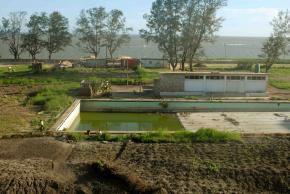
The pool’s changing room was turned into a mosque, making room for the salahs, the five daily prayers ordered by Islam. But there are also churches. Muslims, Catholics, Protestants and Animists live together with no religious conflicts.
Layers of time
In almost all the documentaries, pictures and news stories focusing on the former colonies’ city patrimony, it is the time before and the time after which are challenged. In this obvious match with history it is clear that the present always loses. The images of destruction and degeneration of this present, favor the speech of those longing for the old times, who - even if they recognize the mistakes of times passed - proclaim that it is self-evident that the old times brought with them more dignity to people and made cities better organized. It is enough to observe the luxury of before and the litter of now. In the city of Beira the colonial memory is very much present.
In the restaurant Brique (a little before the Estoril area) where Chinese drink with Africans, Europeans and Indians, we find a Portuguese man, who has been waiting for months for the permit to open his transportation company. He illustrates well the frame of mind of those longing for old times, ”in 1975 when I left, I took a tough beating in Portugal, which was well behind Beira. They didn’t even know what coca-cola was, imagine that! When I came back, a year ago, I took another tough beating seeing Beira all ‘broken down to pieces’. I wasn’t expecting things to be this bad.” This speech and all the alarm concerning the city’s danger -“don’t walk around here at night, I heard there are these guys attacking tourists with machetes”- work as a kind of conscience clearing, the more you underline today’s horror the more you emphasize yesterdays splendor.
In Africa the ones who long for the past appear to be unmistakably right, “colonialism was bad but today’s system is much worse”. This idea seems to cross the minds of all of those who juxtapose these times in a critique-free perspective. The Grande Hotel da Beira, as a building, has in itself the tension of the times that play out here. It had it’s opening in 1955 as a luxury hotel with aspirations of being Africa’s most exquisite accommodations. With it’s 370 rooms and suites and an immense olympic pool, it hoped to promote tourism in all the central region of Mozambique; to serve as home base to discover it’s magnificent coast, attracting in particular the tourists from a white and well to do Rhodesia, and the more affluent Portuguese and British people. A casino was in the plans but the government didn’t allow it. In operation between 1952 and 1963, it never attracted a clientele large enough to obtain the expected ambitious profits, especially with a colonial war pushing tourism away. Topped off with poor management, it ceased existing as a hotel, though keeping the pool and conference room operating throughout the 60’s until after the independence. The architect Francisco de Castro (co-author of the city’s famous railway station) followed the Hotel’s last years of construction. In a documentary by Anabela Saint-Maurice, the architect returned to the Grande Hotel with great emotion. It wouldn’t be unlikely for him to suffer a heart attack on sight of the ruins, but in the end he accepted it: “History’s changes!” Patucha Jardim got married right there, at the hotel, with a big party belonging to the good memories of those times. The Hotel’s last great event was a New Year’s Eve party welcoming 1981, after which it gradually became a ruin. First the military, then members of the police force and of the army started to use the third floor as the war’s logistic support. After 1981, the general population started squatting due to many reasons: it became a refugee camp with Mozambicans dislodged by the war who found a shelter there, political prisoners, the classic exodus from the countryside to the city, and the homeless.
Along with the people already born and raised there, we now have three generations telling the story of the Grande Hotel. Let’s imagine what a guard (with whom we are not able to talk), living there since colonial times, might think; people that cross the moments of history in the same place, spectators of delirious occurrences.
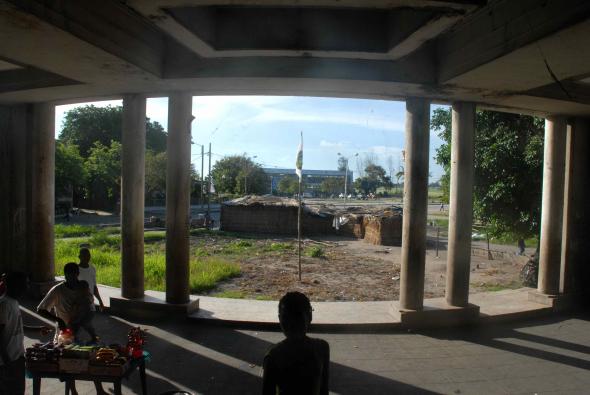
In the film “Night guests” by Licinio Azevedo (2007), two former employees revisit the hotel, 40 years after, talking about the opulence of those times, with whiskies, disco, “ladies”, cigar smoking Americans, sheets in the laundry and all the structure of a great hotel that won’t ever come back to being. In this film we can see clearly the juxtaposing realities and all the inner dynamics of the hotel.
Unfolding and improvements
Beira’s municipality head, Daviz Simango, star of the province of Sofala and who obtained the surprising election result in October’s last election, has already visited the Grande Hotel. In the presence of a representative, the flag of his party, MDM, was raised. He heard the residents’ appeals for the building of communal toilets, and for work materials to assure the building’s maintenance. Mr. Joao is a mason, and there are a lot of capable workers available there, and they would only need rakes, hoes, cement and some money to make the collective “house” pristine. A lot of people there are out of work and survive on odd jobs. But electoral promises – such as the one of connecting the water tube again – are not taken seriously anymore. Maybe due to that, the election period was used to form a pressure group, since they represent a lot of voters. The renovation proposals for the hotel don’t raise any hopes as well, assessing the level of decay and the amount of money needed to make them possible.
The evacuation and relocation talks sound like fiction too; in spite of the Sofala Muslim Association having been able to relocate 30 families, the vacant rooms were immediately occupied again. Space is precious, and children are born all the time. The lives that begin there lack a destiny; they lack more dignified conditions, regardless of the effort to pride themselves with their monumental building. Despite having no outside references and being well adapted to their present conditions, they don’t hide the fact that having a proper house would be better.
The way this great family has appropriated the old hotel structures and shares its space has a lot of common interests. But they would like to know their future… As the future presents itself as a grey realm, they take great care with the leisure areas. In that late afternoon, thunder will fall over the Indian Ocean. But in the hotel a festive night was being prepared, as all Friday nights are, or weren’t they known in Mozambique as “the night of the men”, for they have to party, to drink; and if some of them arrive drunk and disturb a neighbor, tomorrow that would be addressed by the building’s secretaries. “A community has rules”, Mr. João attests, saying goodbye in his stillness and resignation.
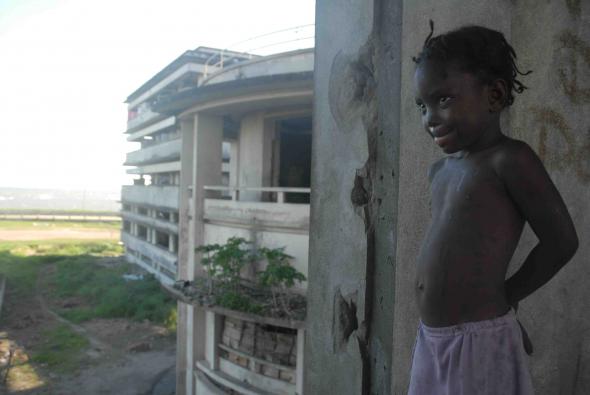
Previously published in Pública, 27/12/2009